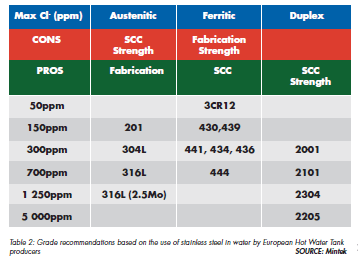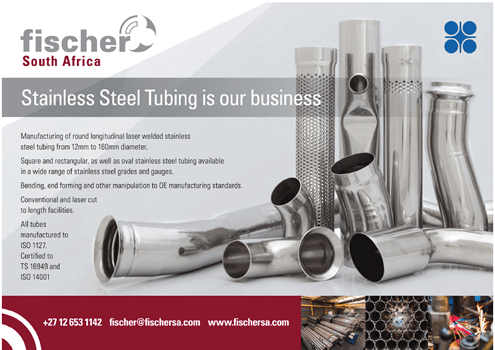Why stainless steel is used in drinking water piping
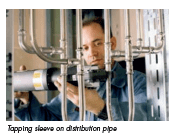 Stainless steels have been used in the treatment, storage and distribution of drinking water for over thirty years. Today that use is increasing and there are opportunities worldwide for further increase. The benefits to society and industry are better water quality and reduced environmental impact at lower cost.
Stainless steels have been used in the treatment, storage and distribution of drinking water for over thirty years. Today that use is increasing and there are opportunities worldwide for further increase. The benefits to society and industry are better water quality and reduced environmental impact at lower cost.
The excellent corrosion resistance of stainless steels when they are applied correctly underlies these benefits. There is no general corrosion so there is no need for a corrosion allowance, or protective coating, or control of water chemistry (except normal biocide treatment), or corrosion protection system. Correct grade selection and good practice will minimise the risk of localised corrosion. Therefore there is practically no contamination of water in contact with stainless steel and equipment will last a long time.
WATER PURITY
Sta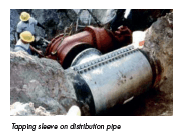 inless steel ensures purity of water, which has been demonstrated in rigorous European tests, which showed that leaching values for chromium and nickel were less than 5% of the maxima permitted by the European Drinking Water Directive and the Committee concluded that “… the use of products made from the specified stainless steel grades in contact with water for public supply would be unobjectionable on public health grounds”.
inless steel ensures purity of water, which has been demonstrated in rigorous European tests, which showed that leaching values for chromium and nickel were less than 5% of the maxima permitted by the European Drinking Water Directive and the Committee concluded that “… the use of products made from the specified stainless steel grades in contact with water for public supply would be unobjectionable on public health grounds”.
DURABILITY
The corrosion resistance of stainless steels means that not only will they last a long time in drinking water applications without replacement but also they will require little maintenance, so reducing operating costs. However, the benefits do not stop there because when the installation is no longer needed stainless steels still have residual value and so are likely to be fully recycled.
Since there is no general corrosion, there are no corrosion products to deposit on internal surfaces which would reduce both the bore and smoothness of the pipe. In turn, this means that the initial flow characteristics of the system will not be impaired, so no extra flow or pumping capacity will be needed during the lifetime of the application – unless there are deposits for other reasons.
There are many old distribution systems in traditional materials which are now suffering through major leakage. The consumers then suffer because they may have supply shortages, they have to pay unnecessarily for the treatment of the wasted water and they may have to pay for extra treatment capacity to be provided. The durability of stainless steels means that their use in distribution networks can reduce the leakage virtually to zero, benefiting consumer, industry and environment alike.
LIGHTWEIGHT INSTALLATIONS
The good ductility, strength, weldability, resistance to high water flow rates and corrosion resistance of stainless steels combine to enable lightweight structures to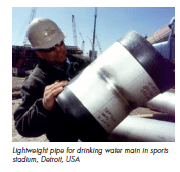 be used. For example, only thin-walled tubes may be needed which can be joined by welding, or by flaring and using loose flanges. In turn, this leads to easier transport to site, greater capability for offsite shop fabrication (better control and cheaper) and easier installation without heavy lifting equipment onto lightweight supporting structures. In some cases, complete package treatment units may be viable.
be used. For example, only thin-walled tubes may be needed which can be joined by welding, or by flaring and using loose flanges. In turn, this leads to easier transport to site, greater capability for offsite shop fabrication (better control and cheaper) and easier installation without heavy lifting equipment onto lightweight supporting structures. In some cases, complete package treatment units may be viable.
The net effect may be an installed cost which is less than the cost of an equivalent system in a more traditional material, in spite of the higher cost per kilogram of stainless steel. Some applications may also achieve weight savings by utilising the higher strength of the duplex grades of stainless steel, for example large diameter buried pipelines or spanning wide gaps.
LIFE CYCLE COST (LCC) BENEFITS
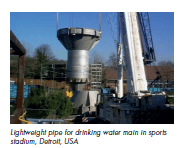 The true cost of a material selection decision has to be looked at over the whole life of the installation. Thus it covers initial, operating, maintenance, replacement and disposal costs – with the latter containing a credit for residual value. These can be compared properly for different material choices by using a standard Life Cycle Cost (LCC) analysis to reduce all the costs to present day values. Apart from the benefits of being lightweight – which impact directly on reducing initial costs – the reduction in the other costs, as discussed above, can often make stainless steel the most cost-effective choice.
The true cost of a material selection decision has to be looked at over the whole life of the installation. Thus it covers initial, operating, maintenance, replacement and disposal costs – with the latter containing a credit for residual value. These can be compared properly for different material choices by using a standard Life Cycle Cost (LCC) analysis to reduce all the costs to present day values. Apart from the benefits of being lightweight – which impact directly on reducing initial costs – the reduction in the other costs, as discussed above, can often make stainless steel the most cost-effective choice.
GOOD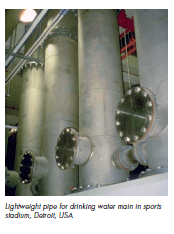 PRACTICE IN THE SELECTION AND USE OF STAINLESS STEELS
PRACTICE IN THE SELECTION AND USE OF STAINLESS STEELS
In common with all other materials, the best performance of stainless steels will only be obtained if the grade has been selected correctly for the application, design is correct, fabrication has been carried out properly and the appropriate maintenance regime is in operation .
GRADE SELECTION
Only a small number of grades of stainless steel are in common use with drinking water. Practical experience and tests have shown that the chloride content of the water is the most important parameter in grade selection because of its influence on localised corrosion – crevice corrosion in particular. This has led to guidelines for ambient temperatures, although other grades with equivalent corrosion resistance may also be suitable. Based on research conducted several years ago at Mintek, the following stainless steel types would be suitable depending on chloride content, using a maximum temperature of 650C. See Table 2.
DESIGN AND FABRICATION
After grade selection, the most important aspect of design is to minimise the opportunities for crevice corrosion at joints by use of welded connections or good detailing.
Galvanic corrosion of other materials in contact with stainless steel must be considered but does not seem to be a practical problem if copper-based fittings are used with stainless steel pipes in a plumbing system. However, electrical insulation between the different metals may be necessary if cast iron, carbon steel or galvanised steel is used in conjunction with stainless steel.
Equipment design also extends to ensuring that treatment chemicals are injected and mixed properly, since in concentrated form they can be aggressive to stainless steels. For example, chlorine injection should be into the middle of the water stream to ensure good mixing, rather than adjacent to the wall of a pipe where mixing may be poor leading to high local concentrations.
There is plenty of guidance available on welding of stainless steels, and housekeeping during material storage and fabrication. Attention must be given to making full-penetration welds and eliminating (or at least minimising) heat tint if the best corrosion performance is to be obtained. This has been a critical topic in presentations on stainless steels targeted at the water industry around the world over at least the last ten years – and remains just as important today.
Iron contamination may only cause cosmetic rust staining on plant but experience around the world is that clients see it as something unexpected and wrong with the stainless steel. It is easily prevented or removed – and should be.


